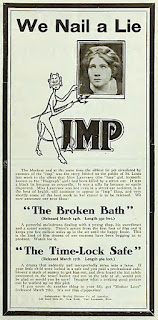What Happened To Mary . . .
Getting Moviegoers to Return for Her Next Chapter
 |
|
Thomas Hardy’s serial novel,
A Pair of Blue Eyes, is considered
the origin of the "cliffhanger”.
|
The classic serial film format uses a plot device where all chapters in the story are interconnected to one another through characters and a common underlying plot. Its ingredients include fast action, suspense, thrills, and a charming love interest. Each chapter closes with a dramatic cliffhanger that is magnet-like in its ability to pull the moviegoer back to the theater the following week to see the succeeding chapter. In comparison, the series format is made up of episodes involving the same main characters in each film, but does not rely on a linking story thread to make it complete.
In 1912 Thomas Edison's Kinetoscope Company released a 12-chapter serial starring Mary Fuller, titled What Happened to Mary, a film most genre specialists regard as a serial-series hybrid. Considered to be the first of its kind in the U.S., each of its one-reel chapter plays contained a short story, which utilized the same underlying plot. The following year Selig Polyscope Company released a 13-installment serial starring Kathlyn Williams, titled The Adventures of Kathlyn. Each of the serial’s chapters existed on their own but related to one another through incidents that loosely tied each together, with minimum regard to the overall plot.
 |
| Pearl White on “Cliffhanger
Point", New Jersey, with cameraman Arthur Miller and director George Seitz. Holding onto George’s jacket is actor Antonio Moreno. |
The success of What Happened to Mary was due to a professionally implemented multimedia marketing campaign created by Edison and S. S. McClure Co., the publisher that ran the serialized-novel in The Ladies' World. Upon hearing about the plans of the story Horace G. Plympton, production department head at Edison, approached Edward A. McManus of McClure and proposed a film tie-in. The Ladies' World, a mass-market woman’s magazine with a circulation of three quarters of a million readers, was already experienced in publishing story and film tie-ins, however, this would be their first serial collaboration. What Happened to Mary would be published as a 12-part serial novel, beginning with the August 1912 issue, to coincide with a 12-episode serial film, premiering in theaters on July 26, 1912. The intent of the tie-in was to create an interest with both readers who would become interested in seeing the film version and moviegoers who would want to read the print version. In the process the publication’s subscription base would increase and additional promotion would be created for the film version.
In a review for The Moving Picture World Epes Winthrop Sargent remarked on the melodrama’s success, “The Mary series seems to have found a field all its own. The series story is familiar enough, but the series story that has a continuation of the same story is another matter. Predictions were freely made when this series was announced, that the fact that the stories were best shown in series would seriously militate against it. That the stories would be released about a month apart was supposed further to act against success, yet the Mary pictures have been run singly, the first five or seven have been brought back for successive nights, the first ten have been played back later and they will be running almost as strongly a year from now. This being the fact, it is to be regretted that other stories are not also made in series instead of individual releases. Twelve Broncho Billy stories in which the same Broncho Billy appeared in all would be a winner and we can imagine what would happen to the magazine that ran the fiction end of it with photographs of Mr. Anderson and his company for illustrations. In the rush for the two and three-part features the connected series seems to have been overlooked.”
 |
|
Charles Dana Gibson’s idea of the
heroine in
“What Happened To Mary”, looking
nothing
like the film’s actress Mary Fuller.
|
 |
|
The serialized format was a new challenge
for theater operators - how do you
get
customers to return for the next episode?
|
As was the case with What Happened to Mary, the early serials were linked to cash prizes that enticed audiences. The front cover of The Ladies’ World August 1912 issue announced, “One hundred dollars for you if you can tell What Happened to Mary.” The contest encouraged readers to correctly guess, in 300 words or less, what would happen to Mary in the second episode. The first installment told the story of Mary's efforts to uncover the secret of her adoption against her stepfather’s advice. At the end of the chapter she begins a new adventure, leaving home with only one hundred dollars. The winner was announced in the September issue as Lucy Proctor of Armstrong, California, who deduced that a young man in his car will rescue Mary.
 |
|
The success of What Happened to
Mary
spun off a Broadway stage production
as well a sequel serial.
|
The success of the marketing strategies used for What Happened to Mary assured future one-reel serials success with magazine and newspaper tie-ins. Marketing was an important tool in the success of serials, and the tie-in was among the most effective marketing strategies. However, as marketing campaigns evolved they became costly. As the popularity of serials grew the serial tie-ins eventually gave way. By 1917 studios and exhibitors questioned the need for large money prizes and free premiums.
Sources:
Canjels, Rudmer. Distributing Silent Film Serials: Local Practices, Changing Forms, Cultural Transformation. New York: Routledge, 2010.
Stedman, Raymond William. Serials: Suspense and Drama By Installment. Oklahoma: University of Oklahoma Press, 1971.
Zmuda, Michael. The Five Sedgwicks: Pioneer Entertainers of Vaudeville, Film and Television. Jefferson: McFarland & Company, Inc., 2015.
Michael Zmuda © 2015




